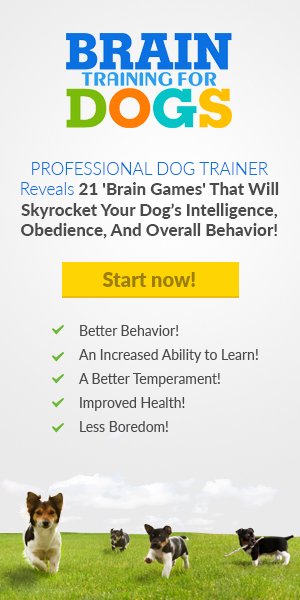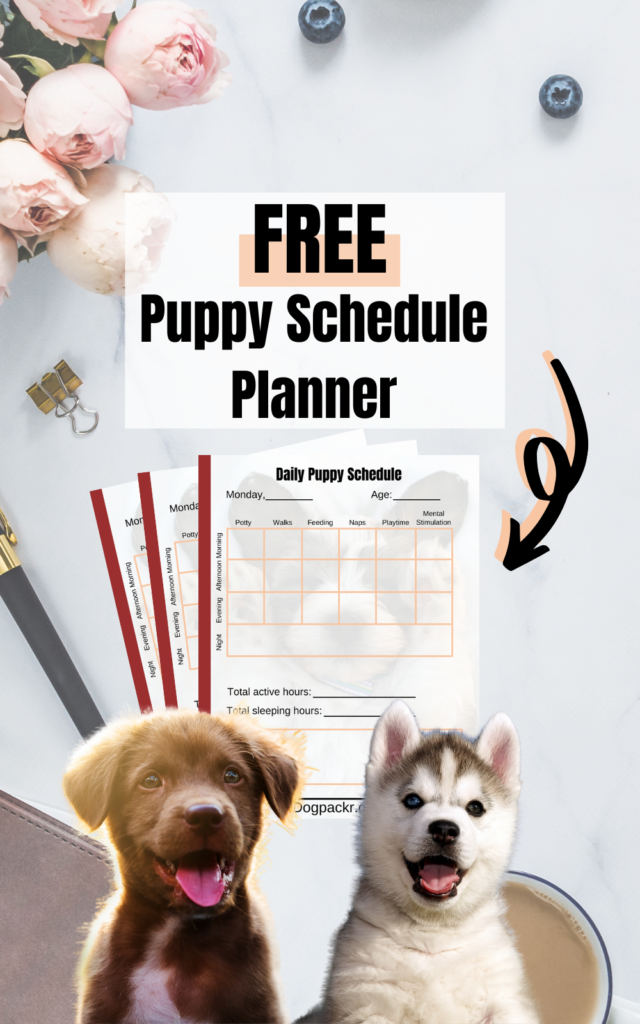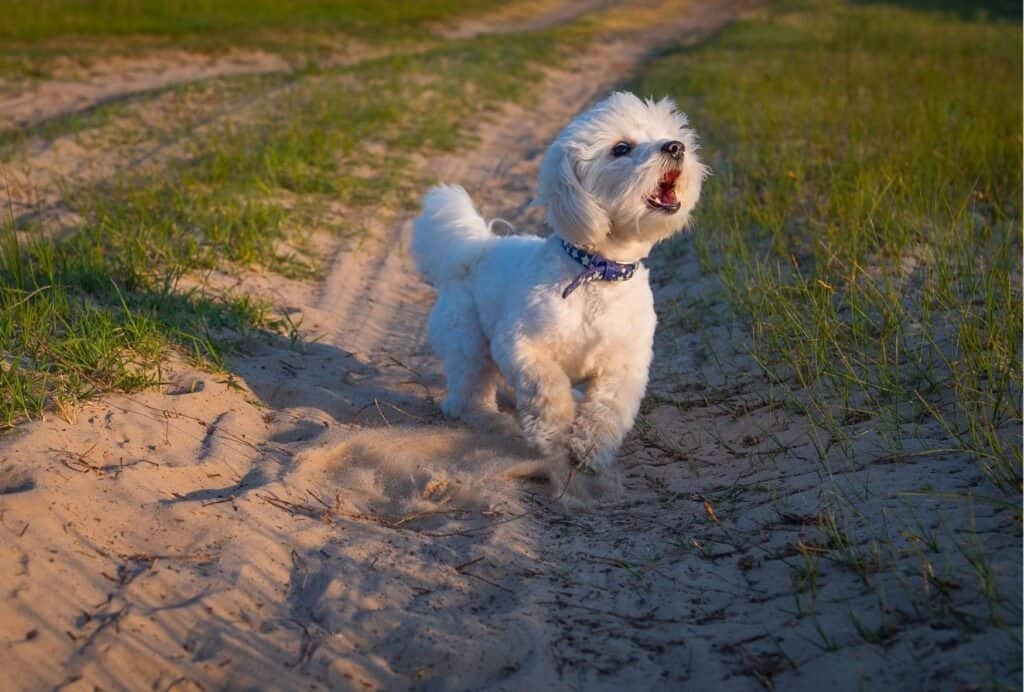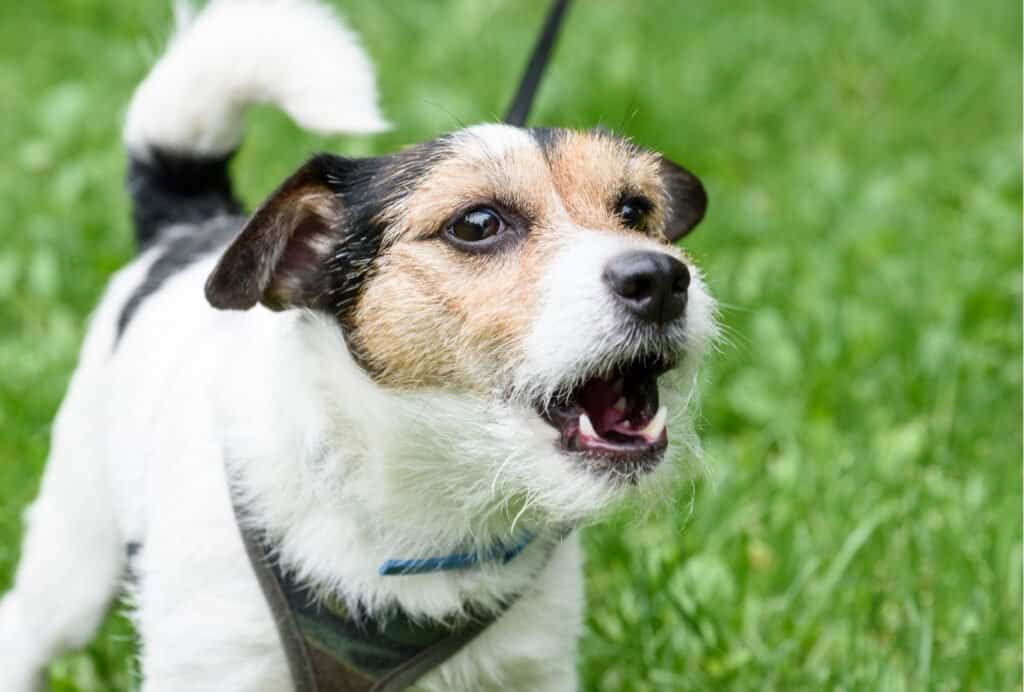Do you own a reactive dog and are dreading every walk?
I feel you, I’ve totally been there!
My Mini Poodle Baloo is reactive towards other dogs. He’s mostly scared and probably tries to overcompensate by being the loudest.
He’s been like that since the very day that I got him as a puppy. And while his reactivity isn’t “cured”, I’ve luckily found a few ways to improve his behavior over the years.
So, in this article I’ll share my 11 tips to walk a reactive dog. Hopefully, some of these will make your walks a little easier as well!
11 tips to walk a reactive dog
If you have a reactive dog, then you know how challenging a walk in the park can actually be.
Before we get into the tips for walking a reactive dog, it’s important to understand the difference between a reactive dog and an aggressive dog.
Reactive dogs tend to overreact in specific situations. Aggression, on the other hand, is directly hostile behavior. Reactivity sometimes escalates to aggression, though.
You might also be interested in checking out these articles:
- My Dog Gets Aggressive When Tired—What Can I Do?
- 6 Signs of an Aggressive Puppy and How to Stop It
- How to Deal with an Over Excited Dog on a Walk
Here, now, are my 11 best tips for dogs that have reactivity issues.
1. Make sure he gets enough mental stimulation
It’s important to give your dog enough daily exercise. But while physical exercise is very important, it’s equally important to exercise your dog’s brain.
Reactivity is often the result of an overactive brain. Therefore, working out your dog’s brain helps keep him calm. Mental stimulation also often more tiring than just physical stimulation. This makes it an effective way to tire your dog out before you go for a walk, which will prevent reactivity.
Giving your dog enough mental stimulation will help your dog stay more relaxed on walks.
For more information and some fun things you and your dog can try, here are 10 brain games for dogs to play at home.
2. Get a harness where you can attach the leash on the front
Part of walking your dog properly means having the right gear. Some people mistakenly believe that they only need a collar and leash.
But the truth is that a collar isn’t necessarily the best thing for your dog—especially if you have a reactive one.
Reactive dogs tend to pull pretty hard on their leashes. If they’re just wearing a collar, then that could hurt them and be really dangerous.
You also don’t get as much control with a collar. Instead, you should consider getting a harness for your dog.
Try to find one that lets you clip the leash to the front of the harness. This will keep your dog safer and gives you better control while you’re walking.
3. Train him to focus on you
Reactive dogs don’t have a lot of control over themselves. Dogs are, generally, very emotional animals. They act out how they’re feeling in the moment instead of thinking things through like we do.
That’s why it’s really important for you to know how to intercept your dog when you can see his reactivity being triggered.
One of the best ways to do this is to train the “focus” command. As soon as you enter a situation where your dog might become reactive, get him to focus on you. This keeps his attention away from his trigger and on you—where it should be!
4. Get some super yummy treats and maybe a clicker
You want to keep your dog’s attention while you’re walking. One of the best ways to do this is by taking along high value treats.
High value treats are your dog’s absolute favorite treats. Whenever your dog makes a choice you like—like not reacting to a trigger—then you should reward him with these super tasty treats.
You may also want to invest in a clicker. Treats are effective, but giving one to your dog can take a few moments. And timing is everything when it comes to training.
You can learn more about clickers and clicker training in these articles:
- 7 Most Common Type of Dog Training and How to Choose The Right One
- What Is Positive Reinforcement Dog Training?
5. Stop walking when he starts pulling
When you’re walking your dog, the number one thing he wants to do is keep moving.
If you keep moving while your dog is pulling, that’s just encouraging the behavior. You’re teaching your dog that if he pulls, he gets what he wants!
That’s not behavior you want to continue. Not only is it uncomfortable, but it can also be dangerous to have a dog pulling you.
That’s exactly why you should stop walking completely if he starts pulling.
Hold completely still as soon as your dog starts pulling. Don’t move until he returns his focus on you.
6. Try to keep your dog below the “threshold”
When it comes to any type of training, you need to set your dog up for success. You can’t expect your dog to simply know the right thing to do—that’s why you’re training him!
Part of setting your dog up for success means making sure that the situations he’s in won’t actually trigger his reactivity and make him lose control. Many trainers refer to this as keeping your dog below his threshold.
You want your dog to be able to listen to you and to turn away from stimuli that trigger him before the reactivity kicks in. It’s your job to make sure he’s able to do that!
7. Move away from stimuli before he crosses the “threshold”
It’s really important to know what exactly triggers your dog’s reactivity. This will help you avoid those situations and keep your dog in check.
If you notice that you’re approaching a stimulus that triggers your dog, move away as soon as you can. Remember, you want to set your dog up for success. Keep him in situations where both of you are still able to control his actions.
8. Take baby steps while training
It’s important to keep your dog in situations where he’s under threshold. But depending on what your dog’s triggers are, it may not be feasible to avoid these triggers forever.
For these triggers, you’ll want to focus on counterconditioning and desensitization. This type of training is extremely effective, and will help your dog become comfortable with his triggers.
Training can take a lot of time, however. And it’s really important not to rush your dog, since that can make things even worse. Always take baby steps when you’re training.
Related topic: For dog training in general I highly recommend you get a program that walks you through step by step, such as Braintrainingfordogs. Certified dog trainer Adrienne Farricelli teaches you to train your dog to be the best dog he can by be using mental stimulation! Check out Dogpackr’s review to see if this is a fit for you!

9. Cherish the small wins
Anyone with a reactive dog understands how challenging it is. It can feel demoralizing, especially since training reactive dogs tends to be a very slow process.
That’s why it’s important to focus on the little things. Celebrate the moments when your dog makes a good choice, no matter how small it seems! This will help you stay positive and hopeful.
And when you stay positive and hopeful, your dog will pick up on that. And that might actually help your training come along faster!
10. For very strong pullers: get a headcollar
If your dog is a particularly enthusiastic puller, then a headcollar may help him learn to stop. These types of collars attach to your dog’s nose.
The headcollar gives you more control over where your dog’s focus is. It also makes it much more difficult for your dog to pull on the leash.
11. Consult a behaviorist
There are many things you can do to help train your dog on your own. But there’s nothing wrong with reaching out for help.
Most dogs with only mild or moderate reactivity can be trained effectively by their owners. But if your dog is extremely reactive, you may want to get some more advice.
A dog behaviorist or a dog trainer can help. If you’re looking into these options, make sure you do your research. Look for a behaviorist or trainer who focuses on positive reinforcement.
When you consult with them, ask a lot of questions, and don’t worry about any questions being silly!
Remember, you are your dog’s advocate. You need to make sure that you’re getting the right help for him.
FAQ about how to walk a reactive dog
By now, you’ve seen quite a few tips that might help you make walking your dog a better experience for the two of you – and any strangers you might encounter.
But you might still have more questions. Next, we’ll try to answer some of the most common ones.
Do reactive dogs get better?
If you have a reactive dog, it may feel like your dog will never improve. You may feel hopeless and frustrated. You might even be wondering if your dog will ever get better.
So can reactive dogs get better?
Yes, but you may need to manage your expectations!
Many dogs who are only a little reactive can easily be trained to stop reacting to their triggers. If your dog has severe reactivity, however, you might just need to change your idea of what “better” is.
With practice, patience and consistency, you’ll see improvements in your dog. You might need to always stay vigilant on walks, but just remember to celebrate the small things. And don’t be afraid to reach out for help if you need it!
Should I stop walking my reactive dog?
Going for walks is a joyful thing for a dog—even reactive ones. You should still walk your reactive dog, but remember to focus on training while you go.
Take baby steps, stay consistent and don’t give up on your dog!
Why is my dog becoming more reactive?
If your dog is becoming more reactive, then you may be trying to force him into situations that trigger him too quickly.
Training a reactive dog takes a lot of time and patience. Remember, you need to keep your dog below his threshold.
Make sure you follow the above tips and take things slow.
Conclusion
As much as you love your dog, reactivity can be really challenging, frustrating and disheartening. But don’t worry—there’s hope for you and your dog!
The most important thing is to make sure that you’re taking things at your dog’s pace. Stay consistent, keep practicing and remember to celebrate the small victories.
*Disclosure: This post may contain affiliate links, meaning, I get a commission if you decide to make a purchase through one of my links, at no cost to you.





